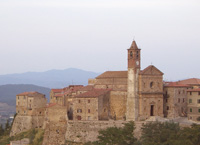| |
|
St. Jerome and a Donor, is signed with an inscription on the tree trunk serving as the base for the crucifix: PETRI DE BURGO SANCTI SEPULCRI OPUS. It is not, however, dated. A variety of dates have been suggested, varying from 1440 to 1450. The diagonal position of the Cross is noticeable. The reason for this seems, however, to have less to do with the perspectival structure of the painting than with the desire to highlight the relationship of the Cross to St. Jerome.
|
 |
Piero della Francesca, St. Jerome and a Donor, detail, (1451) - Panel, 40 x 42 cm, Gallerie dell'Accademia, Venice
|
Piero della Francesca created a further depiction of St. Jerome in the painting of St. Jerome and a Donor, a work which is generally given an earlier date. As with the painting just described, it is signed with an inscription on the tree trunk serving as the base for the crucifix: PETRI DE BURGO SANCTI SEPULCRI OPUS. It is not, however, dated. A variety of dates have been suggested, varying from 1440 to 1450. The diagonal position of the Cross is noticeable. The reason for this seems, however, to have less to do with the perspectival structure of the painting than with the desire to highlight the relationship of the Cross to St. Jerome. The believer, depicted in a red garment and identified by an inscription as Girolamo Amadi, has visited St. Jerome in his hermitage. He is clearly disturbing him at his studies: the saint is in the process of turning over a page in his book. The expression on his face reveals that he is unwilling to be interrupted at his reading. Piero uses contrasts to separate the two figures and their "worlds" from each other. Above the believer, who is wearing a red garment, arches the dense, green crown of a tree, while the saint himself appears in his penitential robe beneath the open, bright blue of the sky.
Piero was able to study the clever spatial shaping achieved by placing color contrasts into the depths of the picture in the frescoes in the Brancacci Chapel in Florence, created in 1425 by Masaccio; here, Masaccio created a masterly example of the concept of advancing and retreating colors, where colors gradually lighten the further away they are, which was perfected during the course of the Quattrocento. In his early work, which includes the Brancacci frescoes, he still preferred the interplay of light and shadow to depict space and positioned contrasts evenly right into the background of the picture.
|
|
 The donor Girolamo Amadi The donor Girolamo Amadi
|
 |
Piero della Francesca, St. Jerome and a Donor, detail, (1451) - Panel, 40 x 42 cm, Gallerie dell'Accademia, Venice
|
|
|
|
| |
|


Holiday accomodation in Tuscany | Podere Santa Pia | Artist and writer's residency
|
| |
|
|
|
|

. |
|
|
Podere Santa Pia |
|
Podere Santa Pia, garden view, April |
|
Arezzo, Piazza Grande |
| |
|
|
|
|
|
|
|
|
|
Caldana |
|
Sovicille, Pieve di San Giovanni Battistaa Ponte allo Spino
|
|
View from Podere Santa Pia
on the coast and Corsica |
|
|
|
|
|
Cantina Petra by Mario Botta in Suvereto |
|
San Gimignano,
view from Rocca di Montestaffoli
|
|
Colle di Val d'Elsa Gavorrano |
| |
|
|
|
|
Gallerie dell'Accademia, Venezia | Accademia Galleries, Campo della Carità, Dorsoduro n. 1050 - Venice
The monumental estate of the Accademia Galleries is located in the prestigious centre of the Scuola Grande of Santa Maria della Carità, one of the most ancient lay fraternal orders of the city. The homonymous church of Santa Maria and the monastery of the Canonici Lateranensi, built by Andrea Palladio, are integral parts of the Accademia.
A very rich collection of Venetian paintings from Veneto as well, from the Bizantine and Gothic fourteenth century to the artists of the Renaissance, Bellini, Carpaccio, Giorgione, Veronese, Tintoretto and Tiziano until Gianbattista Tiepolo and the Vedutisti of the eighteenth century, Canaletto, Guardi, Bellotto, Longhi. These artists will influence the whole history of European painting.
Accademia Galleries, Campo della Carità, Dorsoduro n. 1050 - Venice
www.gallerieaccademia.org |
|
|
![]()













